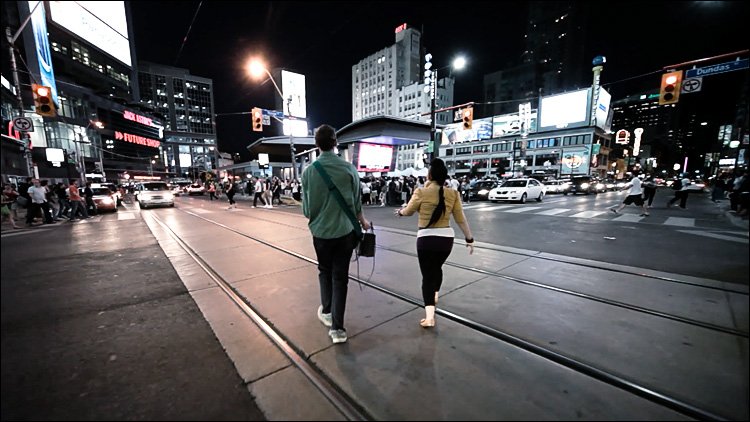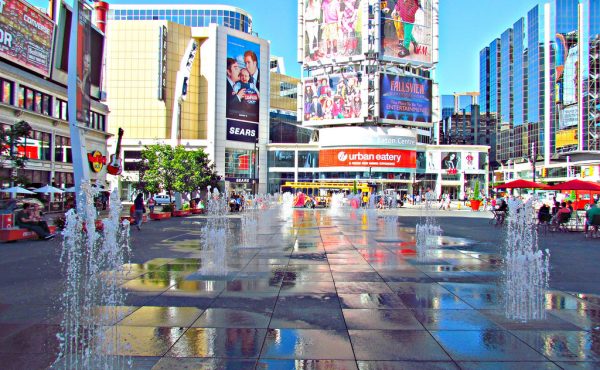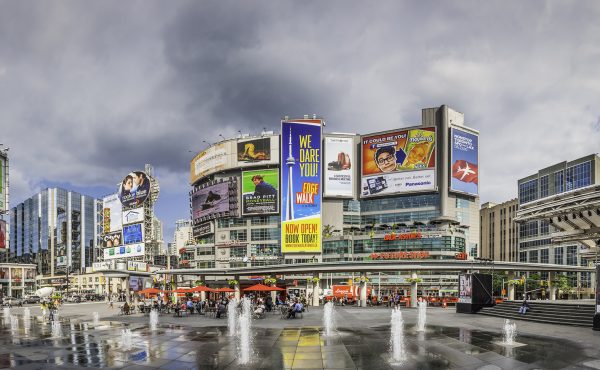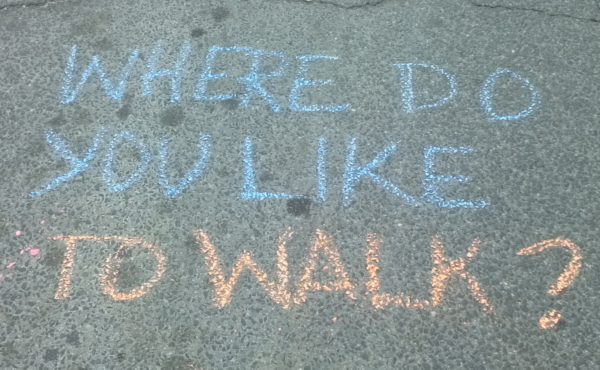

Is it possible that the closest we’ll come to a public space debate during this morbidly fascinating election is a slag-fest over bike lanes real and imagined?
Maybe I was asleep at the keyboard, but I haven’t heard the six candidates so much as peep about the public space file (although it’s only a matter of time before Rob Ford declares the recent Banksy sitings to be some kind of abomination).
Or so I thought, until I learned recently that Giorgio Mammoliti’s suite of “outrageous” platform ideas includes a pledge to transform part of lower Yonge into a pedestrian mall. “I want to make Yonge Street infamous (sic) around the world,” he told me this week, apparently straight up.
Outrageous?
In a recent tweet, my colleague Jonathan Goldsbie nailed it when he described Mammoliti’s candidacy as a “self-consciously absurd performance art project.”
But now the public space crowd must pause to consider whether Mammoliti’s muddle-headed endorsement of a rock solid idea – originally advocated by Matthew Blackett in Spacing’s winter 2009 issue — is a blessing or curse.
Mammoliti’s scheme involves eliminating vehicular traffic from Dundas to Gerard, and he claims he’ll only do it after consulting with the usual cabal of stakeholders.
I think we can agree that Mammoliti got it (almost) right for the (mostly) wrong reasons. Fortunately, though, he’s not out there on the limb by himself. Asked for his thoughts, Joe Pantalone told me last week, “I support the idea of a pedestrian mall on Yonge Street and would push for it.”
But he argues that the Queen-to-Dundas stretch is more “appropriate” because that stretch has only one intersection, where Shuter disappears into the maw of the Eaton’s Centre. Pantalone sees the block as a natural extension to Dundas Square. Indeed, if Toronto wants to replicate Michael Bloomberg’s amazingly successful experiment with the pedestrianization of Times Square, the eastern flank of the Eaton’s Centre seems like an obvious place to start.
George Smitherman also made some sympathetic noises on this topic: “It’s just so regrettable that the city’s main street has sidewalks that are one umbrella wide,” he said Friday. “We’ve seen what’s possible in Montreal where they’re willing to create spaces where people can come together.”
But he hedged his support (glad you were sitting, right?) by saying the city first has to conjure up a comprehensive transportation strategy rather than trotting out “one-offs,” like the recently fletchered University Avenue bike lanes or a Yonge Street pedestrian-only zone.
Yes, let’s do the big traffic plan. But the fact is that Yonge between Queen and Dundas – a fully built-out, street parking-free retail strip served by three subway entrances — is mostly a speedway for taxis. If there’s anyplace downtown where you can shoot first and ask questions later, this is it. Sane people don’t drive there.
As it happened, Smitherman weighed in on another public spacey controversy last week – the waterfront design review panel’s tub-thumping about the four-pad hockey rink complex planned for the Portlands. After the panel’s esteemed planners and architects hurled The Star’s Chris Hume in the direction of the mayor’s office, David Miller pledged to “tinker” with the scheme’s excessive parking requirements and have the city consider a complex with stacked rinks and a smaller footprint.
Smitherman, for his part, called on council to find another location or “ice” the current plan and mull over the possibility of building…stacked rinks. The existing plan, he said, “is a huge set-back for the future prospects of the portlands.”
Setting aside the damned-if-you-do dynamic of this fight (a stacked rink will cost more and the money’s got to be extracted from someone’s hide, likely rink users), the problem with the panel’s somewhat sanctimonious critique is that it imposes unrealistic development expectations on an area that is, let’s face it, about the same size as the rectangle bounded by Parliament, Bathurst, King and College.
That’s a whole lot of city, and it can’t all be prizing-winning architecture. What’s more, there’s something to be said for creating uses that draw large numbers of people to an area that’s been off the radar for decades. A “huge set-back?” Hardly.
Point is, let’s purge cars from those parts of the city where they’re least welcome instead of rushing to judgment about neighbourhoods that won’t exist for decades.
photo by Sam Javanrouh




22 comments
Toronto: A whole lot of city, and it can’t all be prizing-winning architecture.
Well i’ll state the obvious:
The rink will be part of a much smaller neighbourhood as well. I wonder what that will look like with a 400+ (or even 200+) surface parking lot.
I agree with point about the Portlands rink. I think putting the rinks in this location is great as long as the building has the flexibility to fit in with the future neighbourhood plans (stacked rinks should be compatible with a high density mixed use future). Let them have surface parking for now since it can be built over once the neighbourhoods and transit have arrived.
> Point is, let’s purge cars from those parts of the city where they’re least welcome instead of rushing to judgment about neighbourhoods that won’t exist for decades.
Don’t quite see how the “pedestrian mall” is related to “stacking up the rink”? Why cannot both be done? Are they competing for the funding? Or maybe it is still this “war on car thingy”, to gain some on the pedestrian mall front, we have to give some on the rink front?
Sorry John, but I still fail to see your point.
> Toronto: A whole lot of city, and it can’t all be prizing-winning architecture.
True, except that if we don’t even go after excellence on a brand-new neighbourhood designed to lead the way for the city’s future development, then I don’t know we can have award-winning urban planning (sub. architecture). No wonder Toronto is what it is now.
I think it’s having part of Yonge Street made pedestrian only is a great idea.
You could take a good look at an even bigger model where they’ve closed off an entire area down in Burlington VT year round. It’s called the Church Street market and it’s absolutely wonderful.
As someone who has spent a lot of time talking to people about a Yonge Pedestrian Mall, I think it should extend from Queen (or Shuter) north to Gerrard. There are no cross streets, save for Dundas, and the small streets that flow eats and west off of Yonge (Elm, Edward, Gould) are perfect complementary fits to a pedestrian mall.
The true challenge is fixing how he Eatons Centre relates to the street. They’ve begun to have a few stores face onto Yonge, like Baton Rogue, but not nearly enough. But there is a great mix of retail, restaurants, culture venues, etc. on this strip of Yonge to make it a very vibrant and doable pedestrian strip. And as John points out, there will be no battle over parking spaces since none exists on Yonge south of Bloor.
It could be the less expensive but most effective way for Toronto to embrace its most legendary street and turn it into a showcase public space.
I may not be running for mayor, but I am running to be City Councillor for Ward 22, St. Paul’s, and I’ve made revitalising public space one of three key priorities in my campaign.
We lost Yonge-Eglinton Square – most recently the scene of a mass pillow fight – to developers looking to build a glass box of luxury retail. Across the street, however, sits an abandoned bus bay that has been under review by the city since 2006. This space, if properly planned, could replace what RIO-CAN is planning to take away.
I believe what the St. Paul’s area could use more of is better planned public space to help connect the many neighbourhoods (Davisville, North Toronto, Forest Hill) in our community, bringing us all together, which is why I’ve made revitalising public space a priority.
Check out my campaign website: http://www.molls.ca/
Now ‘s the time to build the Port Lands properly to set a good precedent for further development. Despite the neglect, the area is quite central and a logical place to deploy our best urban planning talent. It’s more scenic than other parts of the city despite its current largely post-industrial state: the dramatic ship channel can be complimented with other canals for a very unique area in Toronto where great architecture could meet unique waterfront settings.
I want the prominent complex to be attractive with good urban planning to inspire the development of the new neighbourhoods. I don’t Torontonians to wait a hundred years before the Port Lands is a great area. “Well, it’s better than what was there before” is a lousy mantra for city-building! I wonder if the residents and urban planners of Montreal or London have such a mentality over the redevelopment of a central area in their cities.
Also, Smitherman has spoken out on public spaces more than you’ve mentioned, John. He commented on the poor maintenance on one of our crown jewels of our public spaces: High Park. Almost every asphalt path is in very bad shape, the roads through the park are still lined with ugly overhead wires, and every sign in the park seems to have graffiti on it. Smitherman has also said that Rouge Park should be a national park.
Lastly, it’s odd that what was not mentioned in this article was the failure of the Yonge pedestrianization project in the 1970s. We might be able to make it work this time, but it deserves a mention. I think that Yonge should be reduced to two lanes downtown for wider sidewalks and trees. We also need more sidewalks with attractive pavers instead of having concrete everywhere.
Done right, I don’t think the idea is outrageous. You’d have to be pretty stupid to drive there anyway and Yonge street is kind of sad these days.
But shouldn’t we start by making Kensington pedestrian-only?
“Fletchered” as a verb. Love it.
“self-consciously absurd performance art project”? Does that mean Mammoliti has more in common with Keith Cole than I originally thought?
“The true challenge is fixing how he Eatons Centre relates to the street. They’ve begun to have a few stores face onto Yonge, like Baton Rogue, but not nearly enough”
I’m not sure the Eaton Centre can do much more then it has. Between Roots and Baton Rogue, the street rises from level 2 to level 3 of the mall, so none of the stores are at street level.
“High Park. Almost every asphalt path is in very bad shape”
I read in the paper the path through the leash free area is going to be resurfaced this summer.
Re: Comment about Mammoliti’s campaign being a “self-consciously absurd performance art project”. Mammo’s an idiot… but the same comment could apply equally well to any number of pundits commenting on TO’s mayoral campaign. (Just to be clear, I’m not talking about Lorinc.)
Rather than waste time on this latest ‘go nowhere, pie in the sky, still be talking about it 25 years from now’ pipe dream.. why not head in the logical direction: Kensington? Rather than the current, closed for 6 hours once a month token pedestrian thingy, make it a true, pedestrian area.
I left Toronto because I became sick and tired of the half-assed implementation of just about everything. The same issues that I championed in the 80’s and 90’s are STILL being debated! If anything ever does become reality (other than bland condos) it always winds up being a half-assed, half-baked compromise.
When Kensington becomes pedestrian 24/7 then, and only then, will I ever dream of any part of Yonge becoming pedestrian. Kensington is the logical starting point. Start pushing for that now and maybe.. 20 years or so down the road.. it may be half-closed, half of the time. Maybe!
By the time any pedestrian mall is built in Toronto the ‘stores’ in those areas will have had their property tax capping protection expire. They will face the same problems as ground floor retail does in new condo development. Namely that the taxes make them unviable. From the city……..
The development industry, in its response to the City, has identified a market performance problem with respect to the sale or leasing of at-grade detail and service use space in multi-storey mixed use or office developments. In some such developments, the City has required the inclusion of such at-grade space in the zoning by-law. The development industry feels particularly aggrieved where the space has been required by the City and then sits vacant for long periods of time. They assert that the inequitable tax structure with respect to retail uses is a primary reason that this space remains vacant.While no actual statistics are available to confirm the difficulties in the sale or lease of at-grade retail and service use space, anecdotal observations do confirm that in some areas of the City vacancies in new mixed use developments do exist. While it is likely that the greatest deterrent in these circumstances is the level of property taxes as it relates to projected market returns, staff has considered, but rejected, as discussed below, development charge relief to support the objective of creating shopping streets along major roads.Street-related retail and service uses are desirable in many multi-storey developments on shopping streets to help animate and revitalize the street and create a safer, more diverse, attractive and interesting pedestrian environment. The presence of such retail and service uses also improves the quality of the residential and/or work environment in adjacent neighborhoods.Staff has considered the possibility of development charge relief in order not to exacerbate market performance problems where in fact such problems may exist. The real reasons for any poor market performance appear to be the inequitable property tax structure and, in some locations,lack of effective market demand. Unfortunately, a development charge exemption will not alter this reality because the development charges are not a significant factor in the cost of constructing the retail space.Citywide, a market performance problem for retail and service use space in general has not been identified
http://www.toronto.ca/legdocs/2004/a…5rpt/cl001.pdf
Sorry I meant to add that planning cannot take place in a vacuum. If the city wants vibrant neighborhoods then it needs to do more than just plan for them. It must identify and address impediments to achieving them. Look at the areas of Toronto that have vibrant street life, what they all have in common is that the buildings are old (save for some pathological exceptions). The rents are are reasonable because the taxes are capped.
A pedestrian Yonge Street would be wonderful, as long as they go all out. That means not just closing it off from vehicular traffic, but also providing for patios in front of the buildings, plantings down the middle of the street, comfortable places to sit and places to meet. Getting cars out of there would make Yonge St better than it is now, but great public spaces don’t happen by accident.
I’d say Kensington Market actually has a greater need for car access (i.e. delivery vans, etc.) than Yonge St. Honestly, going to something like woonerfs, where cars aren’t outright prohibited but are treated as guests that must cooperate with people on foot, might be a better fit.
Kensington works because it doesn’t work. The traffic maze is just that. The alleys end in walls. The streets are too narrow. And to all who propose reforms, I would only say that it’s really important to ask what the unintended consequences of such changes will be. Montreal turned its Chinatown into a pedestrian zone, and that killed it as a viable market.
On the other hand, lower Yonge suffers from a kind of corrosive neglect that does not afflict Kensington. Interestingly, the city’s official plan essentially ignores lower Yonge. There is no secondary plan for the area. It is the eastern boundary of the university and the western boundary for the gay ghetto/Ryerson, and thus gets overlooked. The Five project, at Yonge and St. Thomas, should be telling the city’s planning department that they’d better get on the stick and figure out how Yonge Street will, or could, evolve in the next two decades, because there’s a lot of vulnerable low-rise south of Yonge. And if the city does engage in such a discussion, as it desperately needs to do, the pedestrian mall concept should be an integral element of the planning. Now’s the time to start.
Kensington market almost get it right as it is right now. It is already pretty much a de-factor woonerfs, it does not need to be totally pedestrianized. Just small tinkering to make it clear that it indeed is a woonerfs zone. Put up signs, get rid of the curb, maybe just paint two lines to mark where the cars is supposed to be, maybe change the pavement (at least at the entrance of the woonerfs zone) to mark the difference.
Kensington is fantastic as it is with all its messiness and vibrancy. Please, urban planners, leave it alone! Speed-bumps, signs, paint markings, etc. – all these attempts to allocate a function to a space will ruin it.
re: Portlands — the point is not that all of it (or any of it) has to be prize-winning architecture; the point is whether it conforms to various planning and urban design goals — density and efficiency of land, urban form, fine grain of uses, treatment of parking (location and quantity) etc. Those principles are echoed throughout the various waterfront planning documents, while there is comparatively little on architecture (and lots of the renderings show generic blocks/buildings to illustrate these general principles). People would (or at least should) be just as offended if Frank Gehry volunteered to design a four-pad that otherwise maintained the same suburban density, urban design principles, parking… lipstick on a pig etc.
Lots of Toronto consists of generic (and arguably bland) architecture that works because of the urban design context — it blends in rather than calling attention to itself.
A pedestrian mall needs to be both a route and a destination. Only one commenter has mentioned that the experiment has been tried, and failed, to which I would add, failed catastrophically. The original mall, which I remember well, shifted the culture of Yonge below Gerrard to the nasty mix of head shops, sex-trade related businesses, drop in centers and so on.
The failure then was that the Yonge Mall was designed as a destination, but not a route. This is still true, and the plans and ideas look to me, who spent time on that awful seedy mall, as naive and historically ignorant.
There’s no reason to use Yonge St as a route: the subway is better for those in a hurry, and the Eaton’s Center is better for those who are not. The irony is that the Eaton’s Center is that pedestrian mall: it’s a route and a destination, and has never been empty. It’s a synthetic streetscape that is more interesting to most people than the actual streetscape, including above Dundas, so no-one wants to run a store outside it, and any commerce either feels second-rate or needs to carry the consumer reassurance of branded product.
And it recapitulates the insights of 19th century arcades: it also creates both a more sterile but safer and more controlled version of the surrounding streets and markets, and provides short-cut routes, the way arcades in convoluted medieval street plans provided a quick route to less accessible streets.
Kensington is the choice. Those who oppose planning it should examine if that’s a general belief that planning is fine, except on things that actually matter, and have to be nice and good and functional. That seems like the essential argument they’re making, and I think the insight has value. But they should also consider that Kensington has taken a huge shift away from its traditional role as a support economy for immigrant/entrant groups, and displaced them to be a support economy for self-consciously modelled “alternative” culture. This shift is probably the ultimate death-knell for the market: the areas of the city that have done this have all strangled their own original life to recreate themselves: viz Yorkville, Queen West between John and Spadina, and College. A self-conscious reimagining of Kensington as a planned, official space would acknowledge its reality.